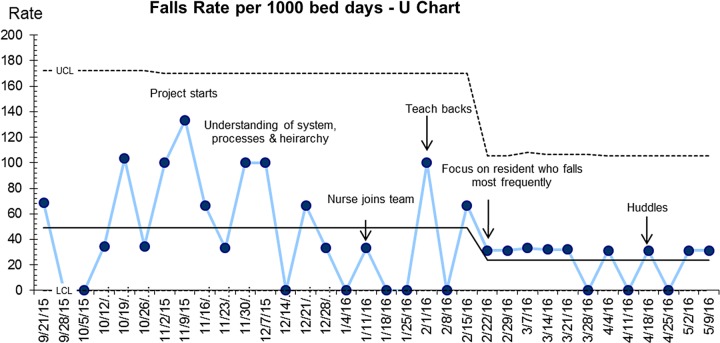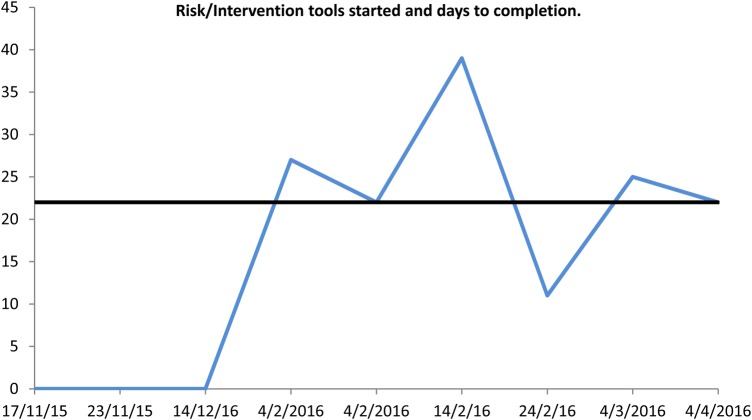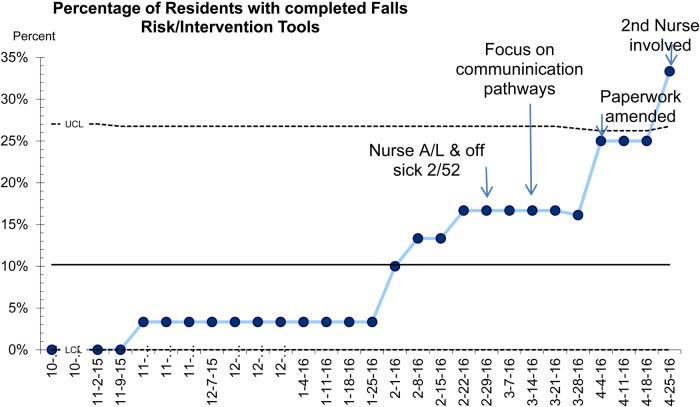减少护理院中的跌倒
摘要
护理院居民跌倒的可能性是社区居民的 3 倍,因此而遭受重大伤害的可能性是社区居民的 10 倍。2 在阿伯丁的一家护理院开展了一个项目,目的是利用改进模式在 2016 年 4 月 30 日前将跌倒人数减少 20%。该项目收集了定性数据,以确定员工对跌倒的看法,以及他们对跌倒风险和如何管理这些风险的认识和理解程度。这为培训提供了依据,并通过引入 "拉纳克郡跌倒风险/干预工具"(Lanarkshire Falls Risk/Intervention tool)开始了迭代测试--在该工具中,对居民跌倒风险的多因素性质进行了探讨,并确定和实施了管理这些风险的具体行动。由于未能实现与员工共享降低风险行动的 PDSA 预测,以及完成该工具所需的时间过长,促使我们将重点放在沟通和完成工具的流程上。我们采用了 "回授 "的方式来强调沟通方面的困难,最终,"Huddles out "的引入改善了居民信息的流动,并为跌倒风险/干预工具提供了参考。完成了 5 次 PDSA,并在其中进行了多次变革测试。在对一名住户跌倒的性质和原因进行了根本原因分析,并应用了工具和沟通流程后,改进工作发生了转变。平均跌倒率从每 1000 个住院日 49 例降至 23.6 例,并因重视沟通的重要性而得以保持。跌倒率下降 36.6% 的目标已经实现。护理院居民跌倒的可能性是社区居民的 3 倍,因此而遭受重大伤害的可能性是社区居民的 10 倍。2 在阿伯丁的一家护理院开展了一个项目,旨在利用改进模式在 2016 年 4 月 30 日前将跌倒人数减少 20%。该项目收集了定性数据,以确定员工对跌倒的看法,以及他们对跌倒风险和如何管理这些风险的认识和理解程度。这为培训提供了依据,并通过引入 "拉纳克郡跌倒风险/干预工具"(Lanarkshire Falls Risk/Intervention tool)开始了迭代测试--在该工具中,对居民跌倒风险的多因素性质进行了探讨,并确定和实施了管理这些风险的具体行动。由于未能实现与员工共享降低风险行动的 PDSA 预测,以及完成该工具所需的时间过长,促使我们将重点放在沟通和完成工具的流程上。采用了 "回授 "的方式来突出沟通方面的困难,并引入了 Huddles 来改善信息流。完成了 5 次 PDSA,并在其中进行了多次变革测试。在对一名住院病人跌倒的性质和原因进行了根本原因分析,并应用了工具和沟通流程后,改进工作发生了转变。平均跌倒率从每 1000 个住院日 49 例降至 23.6 例,并因重视沟通的重要性而得以保持。跌倒率降低了 36.6%,达到了预期目标。



Care home residents are 3 times more likely to fall than their community dwelling peers and 10 times more likely to sustain a significant injury as a result. 2 A project commenced at a care home in Aberdeen with the aim of reducing the number of falls by 20% by 30st April 2016 using the model for improvement. Qualitative data was gathered to establish staff belief about falls and their level of knowledge& understanding about falls risks and how to manage these. This informed the training which was delivered and iterative testing commenced with the introduction of the Lanarkshire Falls Risk/Intervention tool - where the multifactorial nature of a resident's falls risks are explored and specific actions to manage these are identified and implemented. Failure to meet PDSA predictions about sharing risk reducing actions with staff and length of time to complete the tool prompted a focus on communication and the processes whereby the tool is completed. "Teach back" was employed to highlight communication difficulties and ultimately the introduction of Huddles out improved the flow of information about residents and informed the Falls Risk/Intervention tool. 5 PDSAs were completed and within them multiple tests of change. The improvement shift came following a root cause analysis of the nature & cause of one resident's falls and applying the tool & communication processes. The average falls rate fell from 49 per 1000 occupied bed days to 23.6 and was sustained because of the attention to the importance of communication. The aim was achieved with a 36.6% reduction in Falls rate. Care home residents are 3 times more likely to fall than their community dwelling peers and 10 times more likely to sustain a significant injury as a result. 2 A project commenced at a care home in Aberdeen with the aim of reducing the number of falls by 20% by 30th April 2016 using the model for improvement. Qualitative data was gathered to establish staff belief about falls and their level of knowledge& understanding about falls risks and how to manage these. This informed the training which was delivered and iterative testing commenced with the introduction of the Lanarkshire Falls Risk/Intervention tool - where the multifactorial nature of a resident's falls risks are explored and specific actions to manage these are identified and implemented. Failure to meet PDSA predictions about sharing risk reducing actions with staff and length of time to complete the tool prompted a focus on communication and the processes whereby the tool is completed. "Teach back" was employed to highlight communication difficulties and the introduction of Huddles improved the flow of information. 5 PDSAs were completed and within them multiple tests of change. The improvement shift came following a root cause analysis of the nature & cause of one resident's falls and applying the tool & communication processes. The average falls rate fell from 49 per 1000 occupied bed days to 23.6 and was sustained because of the attention to the importance of communication. The aim was achieved with a 36.6% reduction in Falls rate.

 求助内容:
求助内容: 应助结果提醒方式:
应助结果提醒方式:


